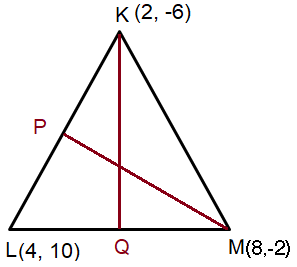VERIFYING GEOMETRIC PROPERTIES OF TRIANGLE USING ANALYTIC GEOMETRY
Problem 1 :
The vertices of a triangle are K(2, -6), L(4, 10) and M(8, -2). Let P be the midpoint of KL and Q be the midpoint of LM. Verify that :
a) PQ is parallel to KM
b) PQ is half the length of KM.
Solution :

a)
Given, K(2, -6), L(4, 10) and M(8, -2)
Let P be the midpoint of KL.
Midpoint formula is
K (2, -6) and L (4, 10)
x1 = 2, y1 = -6, x2 = 4, y2 = 10
Let Q be the midpoint of LM.
Midpoint formula is
L(4, 10) and M(8, -2)
x1 = 4, y1 = 10, x2 = 8, y2 = -2
Slope of a line formula :
Let P = (3, 8) and Q = (6, 4)
x1 = 3, y1 = 8, x2 = 6, y2 = 4
M(8, -2) and K(2, -6)
x1 = 8, y1 = -2, x2 = 2, y2 = -6
So, PQ is parallel to KM.
b)
P = (3, 2) and Q = (6, 4)
x1 = 3, y1 = 2, x2 = 6, y2 = 4
PQ = √[(6 - 3)2 + (4 - 2)2]
= √[32 + 22]
= √[9 + 4]
PQ = √13
PQ = 5
K(2, -6) and M(8, -2)
x1 = 2, y1 = -6, x2 = 8, y2 = -2
KM = √[(8 - 2)2 + (-2 + 6)2]
= √[(6)2 + (4)2]
= √[36 + 16]
KM = √52
= √(2 x 2 x 13)
= 2√13
Length of KM = 2 length of PQ
Problem 2 :
Given ∆ABC with vertices A(-7, 3), B(-2, -3) and C(4, 2).
a) Classify the triangle by side length
b) Verify that one median of the triangle is perpendicular to one of the sides.
Solution :
a)
Given, A(-7, 3), B(-2, -3) and C(4, 2)
l = √[(x2 - x1)2 + (y2 - y1)2]
A(-7, 3) and B(-2, -3)
x1 = -7, y1 = 3, x2 = -2, y2 = -3
AB = √[(-2 + 7)2 + (-3 - 3)2]
= √[(5)2 + (-6)2]
= √[25 + 36]
AB = √61
B(-2, -3) and C(4, 2)
x1 = -2, y1 = -3, x2 = 4, y2 = 2
BC = √[(4 + 2)2 + (2 + 3)2]
= √[(6)2 + (5)2]
= √[36 + 25]
BC = √61
C(4, 2) and A(-7, 3)
x1 = 4, y1 = 2, x2 = -7, y2 = 3
CA = √[(-7 - 4)2 + (3 - 2)2]
= √[(-11)2 + (1)2]
= √[121 + 1]
CA = √122
Since the two sides are equal, it must be a isosceles triangle.
b) D is the midpoint of BC.
B(-2, -3) and C(4, 2)
x1 = -2, y1 = -3, x2 = 4, y2 = 2
Midpoint = (-2+4)/2, (-3+2)/2
= D(1, -1/2)
Slope of AD :
A(-7, 3) and D(1, -1/2)
= (-1/2 - 3) / (1 + 7)
= (-7/2) / 8
= -7/16
Slope of BC :
B(-2, -3) and C(4, 2)
= (2 + 3) / (4 + 2)
= 5/6
E is the midpoint of AC.
A(-7, 3) and C(4, 2)
x1 = -7, y1 = 3, x2 = 4, y2 = 2
Midpoint = (-7+4)/2, (3+2)/2
= E(-3/2, 5/2)
Slope of BE :
B(-2, -3) and E(-3/2, 5/2)
Slope of AC :
A(-7, 3) and C(4, 2)
= (2 - 3) / (4 + 7)
= -1/11
Median BE and AC are perpendicular to each other.
Recent Articles
-
Finding Range of Values Inequality Problems
May 21, 24 08:51 PM
Finding Range of Values Inequality Problems -
Solving Two Step Inequality Word Problems
May 21, 24 08:51 AM
Solving Two Step Inequality Word Problems -
Exponential Function Context and Data Modeling
May 20, 24 10:45 PM
Exponential Function Context and Data Modeling